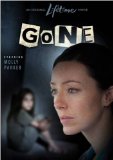By Natasha Samreny
Lifetime movies are like rollercoasters for weak-stomached scare addicts. You know what you’re in for, but you do it anyway. Not every time, but admit it: you’ll put your butt in the seat if your friends are already strapped in. Halfway through you wanna throw yourself from the moving car, but you’re going too frickin’ fast and they beg you to stay, so you do.
Gone is no exception, except I screened this one by myself. If I didn’t have to write a review, I would have switched it off after five minutes, while I was still in the safe zone of not caring enough for the female lead to root for her victory over victimhood. Don’t get me wrong, I like suspenseful and give praise to the powers-that-be when dramas with strong female leads are actually done and done well. But this one was missing too much believability, script and character development to engage me in a memorable film, even for a made-for-TV movie experience.
Canadian actress Molly Parker plays Amy Kettering, a medical nurse whose daughter is kidnapped. Kettering must choose between killing a hospital patient to meet the kidnapper’s demands and finding another way to save her own daughter’s life. The battered patient is a journalist on the run since he uncovered and leaked their shared terrorizer’s plans to steal and sell vital cases of a new vaccine from federal health authorities, affecting a lethal shortage during a flu epidemic. With each character introduced and bit of plot unraveled, the story becomes more intriguing, and I felt like I was watching Scooby-Doo or an old Dick Tracy film, as whodunit layers built through patterned looks and undefinable glances until the master villain is theatrically unmasked in the end. However, besides Parker and a female homicide detective played by actress Lori Triolo, the ensemble of Canadian actors come off as too over-the-top and stilted in their delivery. Whether it was script or performance, this is where I wanted to throw myself from the moving thrill ride.
Most coasters have a formula you can predict: go up, down and get thrown for a few loops. Despite the obvious premise of a victimized woman fighting for something she has lost, the story did leave me guessing about some things until the end. For example, for the past few years, Kettering has struggled to work through a violent rape and assault she suffered at the hands of a masked man in her hospital’s parking garage. Since that night, she is deeply scarred, scared and constantly anxious. But it’s disturbing that the morning before their child is taken, Kettering’s husband David Kettering (Lochlyn Munro) files for sole custody in their pending divorce, tagging her a mother unfit to care for her own daughter Emily (Natasha Calis). Right away, my jerk radar went off and the disgruntled father remained a leading kidnap suspect for the rest of the movie. Besides the character’s insensitivity and other circumstantial suggestions, I kept wondering if Munro’s bad acting was actually an attempt to portray his character’s own shoddy effort at acting to mask possible guilt and involvement in the kidnapping. Another big table- turner comes two-thirds through when the police woman on her case, Liz Cook (Sonja Bennett) turns on her male cop partner, and tells Kettering she’s the only one the mother can trust to help find her daughter. Cook then proceeds to shoot both of them, killing the other cop and leaving Kettering for dead. Anything could happen next.
Action-wise there are several hand-to-hand struggle scenes, including the last two evenly- matched physical fights between Kettering and Cook where we see the former climax metaphorically and physically in her ability to fight for herself and her daughter. In true Lifetime form, the movie does two things well: it cultivates sympathy and empathy for the lead female role, and blurs the lines between knowledge and suspicion, ally and enemy. Kettering’s haunting image of being grabbed in a choke hold at gun point by her first masked perpetrator is played out in part or full with her self-defense instructor and each new terrorizer: the journalist patient, the hospital gunman, the kidnapper, and the female cop, his partner in crime. Women and men who have been victimized in the past can empathize with this nagging, anxiety-driven fear of falling subject to repeat crimes and situations of helplessness. Kettering is attacked and pawn-played by individuals she knows and doesn’t know, but there is no description to warn her of what a terrorist should look like. This is the most intriguing part of the set-up—man, woman, black, white, citizen and cop—they’re all in the mix and switch sides throughout. She has to strike a balance between trusting others again and trusting herself.
Disconnected. That’s how I felt watching Gone, like I was reading a book with a missing narrator on TV, instead of watching a film. It seems director Grant Harvey and writer Ron Oliver produced a second-draft copy of a mediocre script before fully fleshing it out, with actors who only memorized their lines instead of developing their characters. Neat concept, plenty of twists and suspense, but it could have improved with more depth. I want my money back, or at least another ticket for a better ride.



